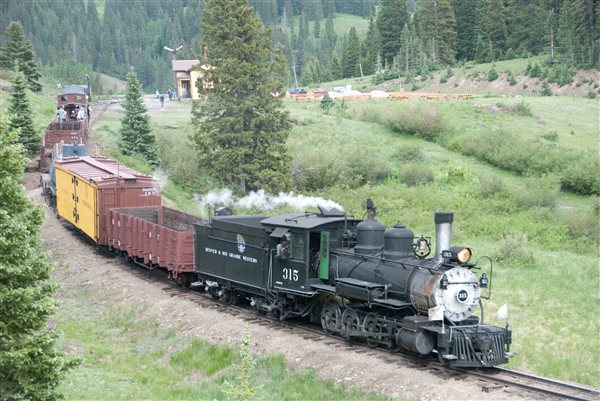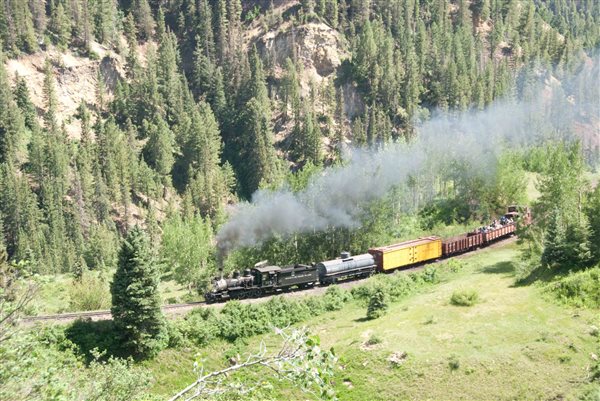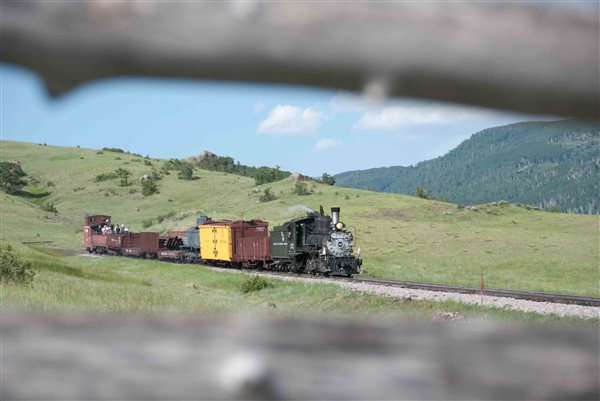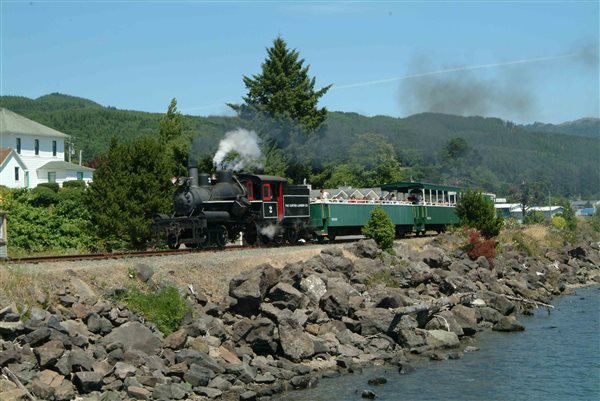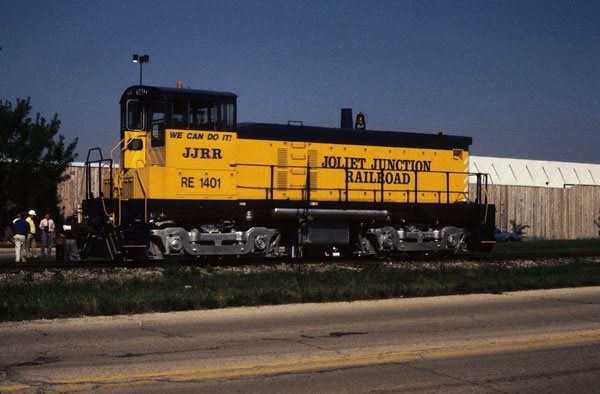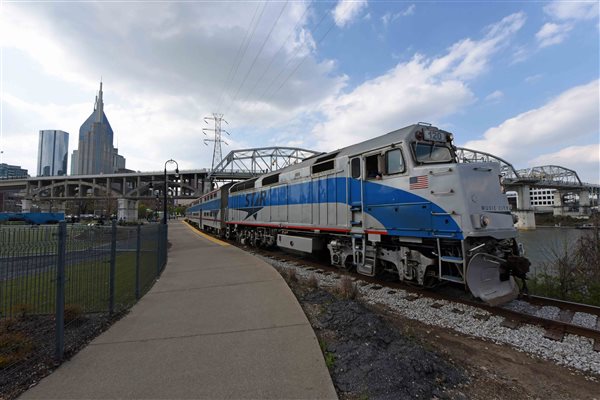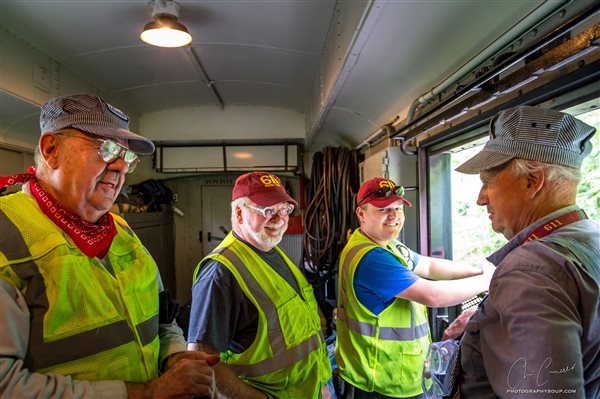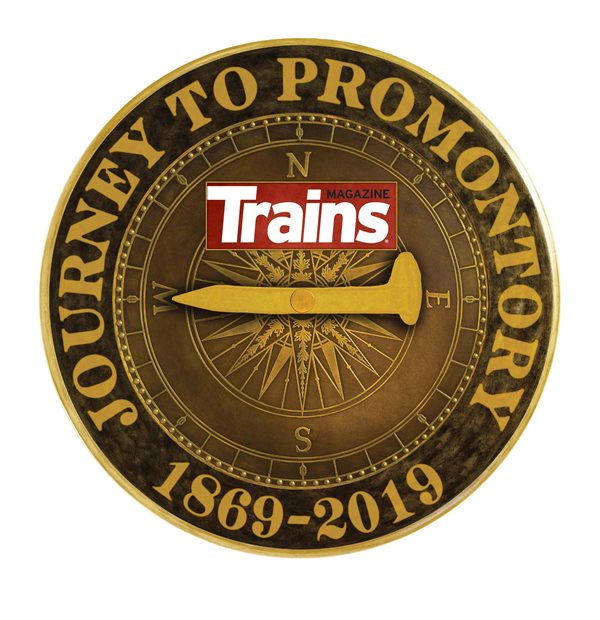![]()
Ross Rowland has been a major figure in American steam locomotive preservation and operation for more than a half century. He is well known as the central figure of the High Iron Co. trips of the 1960s, the American Freedom Train, Chessie Steam Special, Chesapeake & Ohio No. 614, and numerous other projects. I asked Ross 20 odd questions about his affinity for steam, Richard Anderson’s Amtrak, C&O 1309, the Louisiana & Arkansas 503 in Texas, and more. Here’s what he told me.
What’s your favorite brand of gloves for running steam and why?
I use a good quality welder’s glove. In 1970 while I was running Nickel Plate Road No. 759 on the Middle Division of the Pennsylvania Railroad returning from Horseshoe Curve with a 17-car excursion train the engineer’s side water glass failed and instantly filled the cab with steam and noise. I was able to get us safely stopped, and we were able to ascertain the source of the steam, isolate that glass, and resume moving towards Harrisburg. That taught me to A. Always wear long sleeved shirts on steam and B. Always wear good quality welder’s gloves.
What’s the best meal you’ve ever had on board a moving train?
The most memorable meal I've had was hosting my late father aboard my private car the Enterprise on a trip on Amtrak No. 98 from Jacksonville, Fla., to New York City in 1984. Dad was a career long railroader (Central of New Jersey) and we had a great bonding that evening as we sped towards the Big Apple. When we got into the Washington, D.C. area we hit a major snow storm and by the time we got to NYC there was about 2 feet of snow on the open rear platform. Wonderful memories.
If you could sit down to dinner with 3 people from the steam era, who would you pick?
David P. Morgan, Matthias Baldwin, Dante Porta
What two railroad publications would you want to take with you on a desert island?
Trains magazine editions from 1945-1955 and Locomotive & Railway Preservation magazine editions of the 1980s.
What’s your next steam trip?
My next steam trip I hope will be behind the Union Pacific 844 this July, followed by my annual duty as engineer on Baldwin 2-8-0 No. 40 on the New Hope & Ivyland, hauling Santa trains.
No true steam fan should miss this experience:
Riding behind the 844 on the UP at track speed.
What’s your favorite railroad artist?
Bob Lorenz, close second Howard Fogg.
![]()
You were on board the tool car on 611 last year (above left with 611 volunteers and N&W steam author Bud Jeffries in a Chris Campbell photo). What one word sums up that experience?
Memorable.
What locomotive under rebuild today do you most look forward to?
Dead tie. I guess by the tiniest of margins I'd say the Santa Fe 2926 ever so closely followed by the Union Pacific 4014. I've always had a preference for 4-8-4s and that Santa Fe is a beautiful brute (don't tell Chesapeake & Ohio No. 614 I said that !!).
If you could share one insight into the difficulty of restoring and running mainline steam today what would you say?
The most challenging aspect of running mainline steam is keeping all the needed railroad decision makers confident in both the machines ability to do the job and the engines team to bring the professionalism to the table so that all involved will be pleased with the results and not embarrassed.
No steam locomotive is complete without:
A good auxiliary tank, good tool/shop car, and a good crew " mother" to keep the whole thing together.
What’s your take on PTC?
This is a very expensive mostly knee-jerk reaction to a tragic accident caused by human failure. Once fully implemented it will contribute some to helping avoid future bad wrecks and as every human life is priceless in that respect you can make a case that it's worthwhile. No system designed by humans can't be short circuited by humans. The Class I railroads are reluctantly embracing it as they see it long term enabling fully autonomous trains. There's some good work being done by several mainline steam operators to devise a "portable" PTC kit that can be shared by different steam locomotives, thus helping share the considerable costs.
Richard Anderson, the new boss at Amtrak, has been making a lot of big changes. Do you think he’s on the right or the wrong track?
Much too early to tell if he'll be viewed by history as a good Amtrak CEO. His very recent edicts eliminating charter trains and vastly restricting PV movements clearly show his lack of understanding of how important those constituent segments of Amtrak's support web are, and I hope he'll quickly see the mistake here and reverse course on these two items.
Since its birth in 1971 Amtrak's biggest challenge is trying to produce a transportation product that can compete in the marketplace (low cost airlines, buses, interstate highways) who each get massive subsidies that are hidden vs. Amtrak's line item subsidy in each fiscal year’s federal budget. Thus, Amtrak's federal support is an easy target vs. the others that are not. In many respects it's a miracle that Amtrak's national system is still running at all and has survived countless attempts by both parties to eliminate it.
My best guess is that somehow the national system will survive, and that Mr. Anderson will learn that the culture surrounding American railroading has very strong traditions and some aspects of it are very different than operating a successful airline. For his and railroading's sake I hope he proves to be a quick learner.
C&O 1309 has been a potentially great yet tremendously frustrating project for the east. What are your thoughts on finishing the locomotive?
The core issue here is way underestimating the cost of the effort. In 1980 we spent approximately $4 million in 2018 dollars on the rebuild of C&O 614. The 1309 had sat outside for longer than had the 614. No. 1309 is more complicated and any semi-educated guess going in was it was going to cost much more than what was given by the projects organizers. When the funds ran out and the engine remained a good ways short of boiling water the large funders (State of Maryland, the county government, and other donors) lost faith that the management knew what it was doing. My hope is that the State of Maryland will reconsider and decide to put another tranche of money into the project to get the 1309 up and running as she will most definitely bring lots of tourist dollars into Maryland and will help ensure the continued viability of the Western Maryland Scenic Railroad. I have faith that a way will be found to go forward and finish this important project.
What do you think about the situation with L&A 503 in Port Arthur, Texas?
We all owe Jason Sobczynski a huge debt of gratitude for stepping into this issue the night before the scrappers were set to begin cutting this engine into little pieces. Quite to my pleasant surprise his Go Fund Me page raised over $ 65,000 in quick order and with that funding he made a handshake deal with the scrapper hired by the City of Port Arthur, Texas to purchase the engine, load it onto a low boy behind 18-wheelers and truck it to the Texas State Railroad for safe keeping and eventual restoration. As he was doing this the local newspaper brought it to the citizens attention and a handful of them raised enough noise that the City Council canceled the scrappers contract and has now decided to do what's needed to keep the engine in Port Arthur.
Jason is trying his best to convince them to let him use the funds donated by over 1,200 people to take proper care of the 503 and to give it a long-term future and the real chance of coming back to life vs. staying in Port Arthur and going back to being a rusting jungle gym. My read is that the 7 members of the City Council care more about keeping the locals happy than they do about 503's well-being. Hope I'm proven wrong.
If you could build one extinct locomotive from scratch, what would it be?
If I had a magic wand and could bring back one steam engine from the past it would be a New York Central 6000-class Niagara.
If you could pull one locomotive that’s stuffed and mounted out and restore it, what would it be?
If I had the wherewithal to restore any currently stuffed and mounted steam engine it would be the 4-4-4 No. 2929 Canadian Pacific Jubilee Class, currently siting forlornly in Scranton, Pa. I would give her a careful, complete rebuild and then attempt to break the existing steam locomotive world speed record of 127.5 mph with her.
How excited are you that a Big Boy is coming back to life?
What a great project and the best part is its being sponsored by America's most heritage conscious railroad, the great Union Pacific. I'm confident that once Ed Dickens and his team have her back running she will generate more than enough good press for the UP to make them very pleased with their investment. Hope they'll give her a full tonnage train one day and show the world how she and her sisters helped us win WW II and kept the nation moving towards victory in the steam era.
Where will we find you on May 10, 2019?
I'm hoping to be part of the 150th anniversary of the Golden Spike celebration on May 10, 2019, and my dream is to be as near to the 4014 as possible. You know, the linking of America by rail on May 10,1869 is one of the greatest under told stories of our nations growth as before that momentous day it took months and months to get across this vast continent and fully 40 percent of all who tried never made it. If the weather didn't get them, disease, hostiles, and other hazards did. On May 11th. 1869 you could safely go from the East Coast to the West Coast in a predictable 10 days and 11 nights and know you'd arrive in one piece. That changed everything. It allowed the industrial revolution to expand as you could now safely ship vast quantities of heavy things (coal, iron ore, steel, iron etc.) long distances economically and thanks to immigrant incentive programs sponsored by the railroads it facilitated the pioneers who settled the vast great plains, making America the bread basket of the world. It's a great story and I'm confident that between the UP's excellent PR department and Ed Dicken's soon to come alive Big Boy it will get the national coverage it deserves.
Is there are diesel locomotive past or present that comes close to matching the personality of steam?
The only diesels I ever liked some were the FM Trainmasters. I liked the sound they made and how they looked. However, compared to any steam engine no diesel could come close in my heart.
![]()
 1. Hartwell Railroad 2-6-2- No. 11. I knew of this Prairie as a child as it became famous along with sister 2-6-2 No. 108 and 2-8-0 No. 1702 on Arkansas’ Reader Railroad, that 1960s mixed train bastion. Trains covered the Reader often, and Editor David P. Morgan was even on hand for the christening of No. 1702 (now at Great Smoky Mountains Railway in North Carolina). When No. 11 showed up on Georgia’s Hartwell Railroad in the early 1980s, I had to see it. On this late November 1983 day, owner Frank Pollock has the engine running at a gallop with one coach near Airline, Ga. He’d painted the engine in a Southern Railway-inspired green and gold. Sadly, Pollock lost his life in a traffic accident, and No. 11 went wandering to Kentucky, where it ran yet again. Today, it’s on display in Nocholasville.
1. Hartwell Railroad 2-6-2- No. 11. I knew of this Prairie as a child as it became famous along with sister 2-6-2 No. 108 and 2-8-0 No. 1702 on Arkansas’ Reader Railroad, that 1960s mixed train bastion. Trains covered the Reader often, and Editor David P. Morgan was even on hand for the christening of No. 1702 (now at Great Smoky Mountains Railway in North Carolina). When No. 11 showed up on Georgia’s Hartwell Railroad in the early 1980s, I had to see it. On this late November 1983 day, owner Frank Pollock has the engine running at a gallop with one coach near Airline, Ga. He’d painted the engine in a Southern Railway-inspired green and gold. Sadly, Pollock lost his life in a traffic accident, and No. 11 went wandering to Kentucky, where it ran yet again. Today, it’s on display in Nocholasville. 2. Pennsylvania Railroad 4-4-0 No. 1223. The engine used in the movie, “Hello, Dolly!” A real, operating 4-4-0! A real, operating PRR engine. When I caught up to the engine on Pennsylvania’s iconic tourist railroad, the Strasburg Rail Road, I had no idea that No. 1223’s days were numbered. When it needed heavy work to keep it operating, the adjacent Railroad Museum of Pennsylvania declined the railroad’s offer, citing the desire to keep the engine original. It was good while it lasted, and at least No. 1223 is safe inside at the museum. But boy, was she ever a sight to behold in steam, especially on this day, Oct. 2, 1989 at the Groff’s Grove picnic area.
2. Pennsylvania Railroad 4-4-0 No. 1223. The engine used in the movie, “Hello, Dolly!” A real, operating 4-4-0! A real, operating PRR engine. When I caught up to the engine on Pennsylvania’s iconic tourist railroad, the Strasburg Rail Road, I had no idea that No. 1223’s days were numbered. When it needed heavy work to keep it operating, the adjacent Railroad Museum of Pennsylvania declined the railroad’s offer, citing the desire to keep the engine original. It was good while it lasted, and at least No. 1223 is safe inside at the museum. But boy, was she ever a sight to behold in steam, especially on this day, Oct. 2, 1989 at the Groff’s Grove picnic area. 3. Texas & Pacific 2-10-4 No. 610. One of the original Lima Superpower locomotives of the late 1920s, No. 610 proved to be an exciting addition to Southern’s excursion stable between 1977 and 1981. I rode the engine on Atlanta-Toccoa, Ga., and Chattanooga-Harriman, Tenn., excursions in 1978 and 1979, respectively, and spent high quality hours in the open Dutch door, where I could soak up the sights, sounds, and smells of the big Texas-type eating up mile after mile at 50 mph. Today, she’s kept under cover at the Texas State Railroad near Rusk, and pulled out into the sunlight from time to time. I am glad to have ridden behind her and photographed her in action, such as this July 1978 day near Black Mountain, N.C., on the way to the Eastern Continental Divide at Ridgecrest.
3. Texas & Pacific 2-10-4 No. 610. One of the original Lima Superpower locomotives of the late 1920s, No. 610 proved to be an exciting addition to Southern’s excursion stable between 1977 and 1981. I rode the engine on Atlanta-Toccoa, Ga., and Chattanooga-Harriman, Tenn., excursions in 1978 and 1979, respectively, and spent high quality hours in the open Dutch door, where I could soak up the sights, sounds, and smells of the big Texas-type eating up mile after mile at 50 mph. Today, she’s kept under cover at the Texas State Railroad near Rusk, and pulled out into the sunlight from time to time. I am glad to have ridden behind her and photographed her in action, such as this July 1978 day near Black Mountain, N.C., on the way to the Eastern Continental Divide at Ridgecrest.